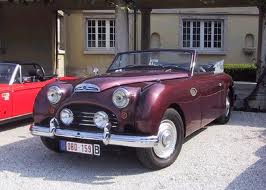A brief history of
Mazda
Introduction
The car manufacturer Mazda has made an important impact on the automotive world. In this article we will give a brief but detailed history of the Mazda marque.
We will look at the origins of Mazda looking at who, why, where and when Mazda was founded. We'll look at the design of the iconic Mazda logo and what are some the more significant Mazda models.
We'll take a glance at what racing history the Mazda has and who some of the most important people have been in the history of Mazda over the years.
Who, where, when and why was
Mazda founded?
Mazda, the renowned Japanese car manufacturer, has a fascinating history that dates back to 1920. The company, originally known as Toyo Cork Kogyo Co., Ltd., was founded in Hiroshima, Japan by Jujiro Matsuda. Mazda's journey began as a manufacturer of cork products but quickly transitioned to producing machine tools and eventually automobiles. The company officially adopted the name Mazda in 1984, derived from Ahura Mazda, the ancient god of light and wisdom.
Mazda's entry into the automotive industry was driven by the vision of creating unique, high-quality vehicles that would captivate drivers around the world. The company's focus on innovation, performance, and the pursuit of driving pleasure has become synonymous with the Mazda brand. Mazda's philosophy of "Jinba Ittai," which translates to "horse and rider as one," reflects their commitment to crafting vehicles that provide a seamless connection between the driver, the car, and the road.
Throughout its history, Mazda has introduced several notable models that have left a lasting impact on the automotive industry. One such significant milestone was the release of the Mazda R360 Coupe in 1960. This compact car became a symbol of Japan's post-war economic recovery and marked Mazda's entry into the passenger car market. The R360 Coupe's success paved the way for Mazda's subsequent achievements and established the brand's reputation for engineering excellence and stylish design.
In the 1970s, Mazda gained global recognition with the introduction of the Mazda RX-7 sports car. The RX-7, featuring a unique rotary engine, showcased Mazda's commitment to innovative powertrain technology. Its lightweight construction, balanced handling, and distinctive design made it a favorite among driving enthusiasts, and it went on to become one of Mazda's most iconic models.
Another notable milestone in Mazda's history came in 1989 with the launch of the Mazda MX-5 Miata. The MX-5, a two-seater convertible sports car, captured the essence of lightweight, open-top motoring. It quickly gained popularity for its affordable price, engaging driving dynamics, and timeless design. The MX-5 became a best-seller, earning a place in the Guinness World Records as the world's best-selling sports car.
Mazda's commitment to innovation and environmental sustainability is exemplified by the introduction of its SkyActiv technology. With a focus on improving fuel efficiency and reducing emissions, Mazda has developed advanced engine designs, lightweight chassis components, and aerodynamic features to enhance the overall efficiency of their vehicles. This dedication to environmental responsibility led to the development of Mazda's first electric vehicle, the Mazda MX-30, which combines an electric powertrain with sustainable materials.
Today, Mazda continues to push the boundaries of automotive engineering and design. The company's lineup features a range of vehicles, from compact cars to SUVs, all embodying Mazda's core values of craftsmanship, performance, and a driver-centric approach. With its rich heritage, commitment to innovation, and a passion for creating cars that evoke emotion, Mazda has firmly established itself as a respected player in the global automotive industry.
How did the
Mazda logo originate?

How did the Mazda logo originate?
The history of the Mazda logo is an interesting journey that has evolved over time. The company's logo represents its identity and values, symbolizing its commitment to innovation and driving pleasure. The earliest logo of Mazda featured a stylized letter "M," representing the brand's name. This logo was simple yet distinctive, embodying the company's dedication to creating unique and memorable vehicles.
In the 1970s, Mazda introduced a new logo known as the "Flying M." This iconic emblem featured a stylized "M" with wings, symbolizing the brand's ambition to soar to new heights in the automotive industry. The Flying M logo became synonymous with Mazda's commitment to innovation and the pursuit of driving pleasure.
Over the years, the Mazda logo has undergone various updates and refinements, reflecting the brand's evolution and design trends. In 1997, Mazda introduced the "Mazda Mark," a three-dimensional emblem that featured a chrome finish. This logo represented the brand's transition towards a more modern and premium image.
In 2011, Mazda unveiled its current logo, known as the "Mazda Symbol." This logo showcases a stylized wing-shaped "M" enclosed within an oval. It represents the brand's dynamic and forward-thinking nature, symbolizing the brand's ability to continuously innovate and push boundaries.
The Mazda logo has not only evolved in design but also represents the brand's core values and philosophy. It embodies Mazda's commitment to craftsmanship, performance, and a deep connection between the driver and the vehicle. The logo's sleek and modern design reflects Mazda's desire to create cars that evoke emotion and deliver a thrilling driving experience.
Today, the Mazda logo continues to be an emblem of the brand's rich heritage and its dedication to creating vehicles that stand out from the crowd. It serves as a visual representation of Mazda's innovative spirit, design excellence, and passion for delivering driving pleasure to customers around the world.
What are some of the significant
Mazda models?
Mazda, as a car manufacturer, has introduced several significant models throughout its history, each leaving a distinct mark on the automotive industry. From innovative technologies to striking design, these models showcase Mazda's commitment to craftsmanship, performance, and delivering an engaging driving experience.
One of Mazda's notable models from the early years is the Mazda R360 Coupe, which was introduced in 1960. The R360 Coupe was Mazda's first passenger car and played a crucial role in establishing the company in the automotive market. This compact car featured a small, efficient engine and a lightweight body, making it an affordable and practical option for many Japanese consumers. The R360 Coupe's success helped Mazda gain recognition as a manufacturer of quality automobiles.
In the 1970s, Mazda introduced a game-changer with the Mazda RX-7. This sports car featured a distinctive rotary engine, which set it apart from traditional piston-powered vehicles. The RX-7 gained popularity for its balanced handling, sleek design, and spirited performance. It became a symbol of Mazda's commitment to innovative technology and driving pleasure. The RX-7's success on the track, particularly in various motorsport events, further solidified Mazda's reputation as a manufacturer that could deliver excitement and performance.
During the 1990s, Mazda introduced the Mazda MX-5 Miata, a two-seater convertible sports car that took the world by storm. The MX-5, also known as the Miata in certain markets, revived the spirit of classic British roadsters with its lightweight construction, responsive handling, and timeless design. The MX-5 quickly became a global sensation, capturing the hearts of driving enthusiasts who appreciated its back-to-basics approach to motoring. Its affordability, reliability, and sheer driving enjoyment have made it the best-selling two-seater sports car in history.
As the new millennium approached, Mazda unveiled the Mazda3, a compact car that blended style, performance, and practicality. The Mazda3's striking design and engaging driving dynamics made it a popular choice among consumers. Its success was driven by Mazda's focus on utilizing lightweight materials, advanced technology, and efficient engines to deliver a responsive and enjoyable driving experience. The Mazda3 became one of the brand's best-selling models globally, showcasing Mazda's ability to create vehicles that catered to both the emotional and practical needs of drivers.
In recent years, Mazda has continued to innovate and push boundaries with the introduction of the Mazda CX-5. This compact crossover SUV combines Mazda's signature design language with advanced technology and exceptional driving dynamics. The CX-5 offers a comfortable and premium interior, a refined driving experience, and a range of efficient engines. It has become a popular choice in the highly competitive SUV market, demonstrating Mazda's ability to adapt to changing consumer preferences while staying true to its core values.
These models represent just a glimpse into the diverse range of vehicles that Mazda has produced throughout its history. Whether it's the compact and sporty MX-5, the practical and stylish Mazda3, or the versatile and capable CX-5, each model reflects Mazda's dedication to creating cars that go beyond transportation, providing drivers with an emotional connection and an exhilarating driving experience.

One of Mazda's Most Iconic Models
Who are some of the most important people in
Mazda's History
Mazda, as a car manufacturer, owes much of its success to the talented individuals who have contributed to its growth and development over the years. These people have played crucial roles in shaping Mazda's vision, design philosophy, and technological advancements, establishing the brand as a respected player in the automotive industry.
One significant figure in Mazda's history is Kenichi Yamamoto. Serving as Mazda's president and later as chairman, Yamamoto was instrumental in leading the company through challenging times. Under his leadership, Mazda embraced the development of rotary engine technology, which became a hallmark of the brand. Yamamoto's commitment to innovation and his belief in the potential of the rotary engine paved the way for iconic models such as the Mazda RX-7 and helped Mazda establish a unique identity in the automotive world.
Another notable person who made significant contributions to Mazda is Matasaburo Maeda. As the former head of design, Maeda played a crucial role in shaping Mazda's design language, known as "Kodo." Maeda's design philosophy focused on capturing the essence of motion and bringing life to Mazda's vehicles through sleek lines, dynamic proportions, and a sense of energy. His designs, seen in models such as the Mazda MX-5 Miata and Mazda3, have received critical acclaim for their captivating aesthetics and harmonious balance between form and function.
In addition to visionary leaders, Mazda has also been fortunate to have skilled engineers who have pushed the boundaries of technology. One such person is Takao Kijima, a key figure in the development of Mazda's SkyActiv technology. Kijima and his team pioneered advancements in engine efficiency, weight reduction, and improved driving dynamics. Their work resulted in a range of SkyActiv engines and platforms that offer excellent fuel economy without compromising performance or handling. Kijima's dedication to engineering excellence has played a vital role in Mazda's pursuit of sustainable mobility and environmental responsibility.
It is also worth mentioning the influence of Norihiro Suzuki, Mazda's former chief designer. Suzuki's passion for human-centric design led to the creation of interior spaces that prioritize driver comfort and intuitive functionality. His emphasis on creating a driver-focused cockpit and incorporating high-quality materials and finishes has elevated Mazda's interior design to a new level of sophistication and luxury. Suzuki's attention to detail and commitment to enhancing the overall driving experience have earned Mazda a reputation for delivering stylish and ergonomic interiors.
These individuals, along with many other talented engineers, designers, and leaders, have played vital roles in shaping Mazda's success. Their dedication, innovation, and unwavering commitment to excellence have propelled the brand forward, allowing Mazda to differentiate itself in a highly competitive industry. The collective efforts of these significant individuals have not only shaped Mazda's past but continue to influence its future, ensuring that Mazda remains at the forefront of automotive design, technology, and driving pleasure.

One of the most influential people in the history of Mazda
Mazda's Racing History
Mazda's racing history is as rich and storied as its road car heritage. The brand's commitment to motorsport has not only showcased its engineering prowess but has also served as a platform for technological innovation and the development of high-performance vehicles. Mazda's involvement in racing has spanned various disciplines and has produced notable achievements, cementing its reputation as a formidable competitor.
One of the most iconic chapters in Mazda's racing history is its participation in endurance racing, particularly the prestigious 24 Hours of Le Mans. In 1991, Mazda shocked the racing world by winning the overall victory at Le Mans with the Mazda 787B, becoming the first Japanese manufacturer to achieve such a feat. The rotary-powered 787B's victory was a testament to Mazda's commitment to unconventional engine technology and its ability to compete with larger, more established manufacturers. The victory at Le Mans was a defining moment for Mazda, solidifying its position as an innovator in the automotive industry.
Mazda's dedication to motorsport extends beyond endurance racing. The brand has also made significant contributions to grassroots motorsport, particularly in the realm of sports car racing. Mazda has a long history of supporting and nurturing aspiring drivers through programs such as the Mazda Road to Indy and the Mazda Road to 24. These initiatives provide talented drivers with opportunities to showcase their skills and pursue their racing dreams. Mazda's commitment to grassroots racing has been further demonstrated through the development of purpose-built race cars like the Mazda MX-5 Cup and the Mazda3 TCR, which have become popular choices for amateur racers and professional teams alike.
Furthermore, Mazda's racing endeavors have not been limited to traditional circuit racing. The brand has also showcased its performance capabilities in rally and off-road competitions. Mazda's involvement in events like the World Rally Championship and the Baja 1000 has allowed the brand to test its vehicles in demanding off-road conditions and further refine their capabilities. Notably, Mazda achieved success in the Group B era of rallying with the Mazda RX-7, demonstrating the brand's ability to compete against some of the most formidable rally machines of its time.
Through its racing endeavors, Mazda has not only sought victory on the track but also used motorsport as a platform to refine and improve its road cars. Technologies developed and tested in the heat of competition have found their way into Mazda's production vehicles, enhancing performance, safety, and efficiency. The spirit of racing permeates throughout Mazda's lineup, ensuring that every Mazda car delivers an engaging and exhilarating driving experience.
Mazda's racing history is a testament to the brand's passion for performance and innovation. From its iconic Le Mans victory to its commitment to grassroots motorsport, Mazda has consistently pushed boundaries and showcased its engineering prowess on both the track and the road. The brand's racing heritage continues to inspire Mazda enthusiasts and drivers around the world, reinforcing the brand's commitment to delivering vehicles that embody the joy of driving.
Summary
Mazda is a renowned car manufacturer with a rich history of innovation and motorsport success. The brand's commitment to pushing boundaries and delivering vehicles that provide an engaging driving experience has made it a favorite among enthusiasts. Mazda's racing heritage, highlighted by its historic victory at the 24 Hours of Le Mans, showcases the brand's engineering prowess and willingness to challenge convention.
From the iconic Mazda 787B's triumph at Le Mans to its involvement in grassroots racing and rally competitions, Mazda has consistently demonstrated its dedication to performance and pushing the limits of what is possible. The brand's racing endeavors have not only led to on-track success but have also influenced the development of its production vehicles. Mazda's commitment to incorporating racing-inspired technologies ensures that every Mazda car delivers a thrilling and enjoyable driving experience.
View Mazda Car Specifications
More Manufacturer Histories.

























